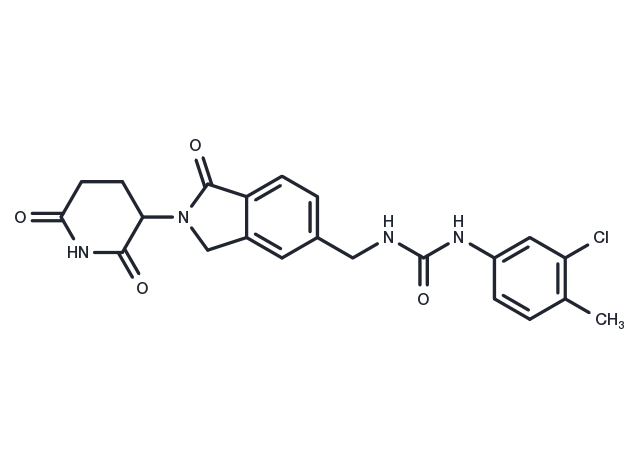Powder: -20°C for 3 years | In solvent: -80°C for 1 year


CC-885 is a modulator of cereblon (CRBN). It has potent anti-tumour activity.

| Pack Size | Availability | Price/USD | Quantity |
|---|---|---|---|
| 1 mg | In stock | $ 51.00 | |
| 5 mg | In stock | $ 122.00 | |
| 10 mg | In stock | $ 172.00 | |
| 25 mg | In stock | $ 322.00 | |
| 50 mg | In stock | $ 522.00 | |
| 100 mg | In stock | $ 759.00 | |
| 1 mL * 10 mM (in DMSO) | In stock | $ 142.00 |


| Description | CC-885 is a modulator of cereblon (CRBN). It has potent anti-tumour activity. |
| In vitro | CC-885 exhibits stronger antiproliferative effects than Lenalidomide and Pomalidomide across various cell types, including acute myeloblastic leukemia (AML) cell lines, THLE-2 human liver epithelial cells, and human peripheral blood mononuclear cells (PBMC), with IC50 values ranging from 10×-6-1 μM. The compound's efficacy was also assessed in 293T HEK cells engineered to express variants of GSPT1 that are either sensitive or resistant to CC-885. The study further explores the mechanism behind CC-885's cytotoxicity, particularly its dependency on cereblon-mediated degradation of GSPT1. By utilizing a GSPT1 mutant which maintains its functionality but lacks the cereblon binding affected by CC-885, the research distinguishes GSPT1's role from other potential targets. Notably, cells overexpressing the CC-885-resistant GSPT1 variant (GSPT1Δ(1–138)/(G575N)) were completely resistant to the compound's inhibitory effects on cell proliferation. In contrast, overexpressing a CC-885-sensitive variant (GSPT1Δ(1-138)) provided only partial protection against these effects, indicating the critical role of GSPT1 degradation in CC-885's mechanism of action. Similar outcomes were observed in AML cell lines[1]. |
| Molecular Weight | 440.88 |
| Formula | C22H21ClN4O4 |
| CAS No. | 1010100-07-8 |
Powder: -20°C for 3 years | In solvent: -80°C for 1 year
DMSO: 67.5 mg/mL (153.10 mM), Sonication is recommended.
You can also refer to dose conversion for different animals. More
bottom
Please see Inhibitor Handling Instructions for more frequently ask questions. Topics include: how to prepare stock solutions, how to store products, and cautions on cell-based assays & animal experiments, etc.
CC-885 1010100-07-8 Others PROTAC Ligand for E3 Ligase Ligands for E3 Ligase CC 885 CC885 E3 ligase-recruiting Moiety Inhibitor inhibit inhibitor
